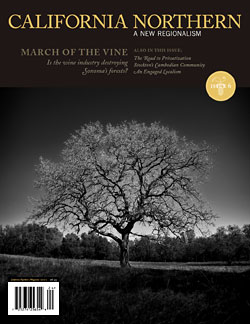The Commune Effect
By Michael Zelenko
There are no fences at the Woodard Lane Co-Housing complex; in fact, there aren’t even yards. Gone are tall hedges, suspicious neighbors, and property disputes; gone is a neighborhood where no one knows anyone’s name. At Woodard Lane, families gather for movie nights and doors swing wide open, inviting everyone to peek in and say hello. Woodard Lane Co-Housing represents the antithesis of suburban alienation: here, the home resembles less a castle than a cell in a bee colony. In a sense, it is a scion of communal utopianism, carefully incorporating lessons learned from centuries of communal experimentation.
So, Woodard Lane should feel radical. But it doesn’t. Instead, it feels like a friendly place where people care about each other, a place where your next-door neighbor might knock on your door after hearing an unexpected sound in the middle of the night. More than anything, it feels like a nice neighborhood. Tucked into a quiet corner of a suburb outside Olympia, Washington, the property resembles a typical apartment complex. In a small clearing surrounded by trees, conventional, non-electric family cars crowd a neatly paved and numbered parking lot. Beyond the lot are three boxy buildings and a somewhat yellowed lawn. A chicken coop sits on one corner of the property and a large vegetable garden on another. But apart from the chickens and the garden, there are none of the stereotypical signs of communal living: no tents bedecked with dream catchers and no painted school buses. Other than a few toddlers playing on the lawn, everyone still has their clothes on.
I’ve come at the invitation of Oriana Lewis, a resident of Woodard Lane, and I’ve come to see a model for a possible future society: an alternative to bumper-to-bumper traffic, large tract developments, and disinvested neighborhoods. Oriana invites me into her apartment and gives me a tour. It’s as clean and tidy inside as the building is outside. Built in 2010, the living units are separate and self-sufficient. Oriana’s appliances look brand new, or close to it; her apartment is small but not uncomfortable; and, even with two cats, the apartment still smells of fresh paint. There is no sense of the discomfort one might associate with communal living.
This is not to say that Oriana and the rest of the Woodard Lane residents don’t value the communal nature of their endeavor. Each member is required to participate in one of a number of committees and to vote regularly in general assemblies. Residents decide together which admission applications to accept, and everyone at Woodard Lane is strongly encouraged to participate in the group meals held three times a week.
Woodard Lane currently consists of about thirty people hailing from all walks of life—ranging from a grandmother interested in “fabric arts” to a family of three simply looking for a saner life. In fact, Woodard Lane’s residents often cite the pursuit of a “saner life” as their motivation for joining. Some desire to be more connected to the community they live in. Still others see living communally as an opportunity to curb resource consumption and decrease their impact on the environment. In the next few years, Woodard Lane hopes to expand to fifty residents, with additional apartments and a common house scheduled for construction.
Oriana invites me to sit on her balcony, where she tells me about Woodard Lane. Smiling warmly through our conversation, she appears to be an inherently social person—a trait she puts to use as a counselor at the Thurston County Dispute Resolution Center. Living communally inspires her and resonates deeply with her beliefs and ideals. I ask her why she lives here, and she tells me that her decision to live communally was a natural one. “It just feels right.” The fact that communal living dates back almost two hundred years in Oriana’s family only comes up as a secondary reason.
Oriana Lewis is the direct descendent of Robert Owen, the nineteenth-century godfather of communalism in the U.S. A socialist at a young age, Owen was troubled by what he saw as the nefarious byproducts of industrialization in his home country of England. Owen sought out alternatives to the cold grind of capitalism and found inspiration in the religious communal experiments of Scotland and the Shaker movement in the U.S. As a result, Owen began to introduce progressive practices into his booming textile business. One of Owen’s most enduring contributions was the advent of early childcare, which he introduced to his factories in 1809. For a low fee, children as young as one year old could be dropped off at infant school. The program freed mothers to work and created a prototype for modern daycare. (It would take three more decades before a German instructor named Friedrich Froebel would introduce a similar system to the wider public, labeling it the now-ubiquitous “kindergarten.”)
In 1824 Owen moved to the U.S. hoping to further realize his ideas in the form of a colony, and the next year, he founded what is now regarded as the first socialist commune in the United States: New Harmony, Indiana. Owen was, by the time of the commune’s founding, a strident utopianist who harbored ambitious dreams. New Harmony began as a waiting room of sorts, where Owen and like-minded individuals lived while they began construction of the radical new living environments known as “Agricultural and Manufacturing Villages of Unity and Mutual Co-operation.” Each village was to be built in a quadrangle of one thousand feet per side, enclosing gardens, gymnasiums, music rooms, lecture halls, and museums. Each village would house two thousand citizens. But before construction of the first village had even begun, the New Harmony commune had already disintegrated.
Despite its short lifespan (the commune lasted a total of two years), New Harmony is regarded as one of the most significant communal experiments in the history of the United States, and Owen as one of the most prominent figures in U.S. socialist history. Thanks to Owen’s emphasis on education, New Harmony became a scientific mecca of nineteenth-century America, drawing scientists and scholars from across the country. Owen undertook influential projects during New Harmony’s existence: he continued to develop his infant care system, introduced the trade school system to the United States, and expanded educational opportunities for adults, all the while promoting economic equality and advocating then-radical women’s rights such as access to abortion and freedom to divorce.
The story of communal living in the United States, spanning nearly two centuries and bookended by New Harmony and Woodard Lane, Robert Owen and Oriana Lewis, is a story seldom told. And yet communes have bred many of the values we now appreciate and take for granted, including women’s rights, fair labor practices, and universal education. Over the decades they’ve successfully shuttled radical concepts—early childcare being just one example—out of the fringe and into the spotlight.
Nowhere has this been truer than in Northern California. As one of the central hubs of communal experimentation, the region has played an important role in fostering radical nineteenth-century utopian communities such as the Kaweah Co-operative Commonwealth, Altruria, and Fountain Grove, along with twentieth-century communities such as Morningstar and Black Bear Ranch. In turn, these communes have changed the ambitions, values, and priorities of not only our state, but also our country as a whole.
This is an excerpt of “The Commune Effect”

